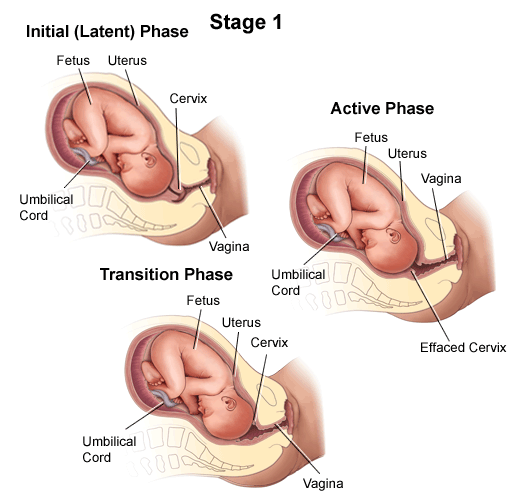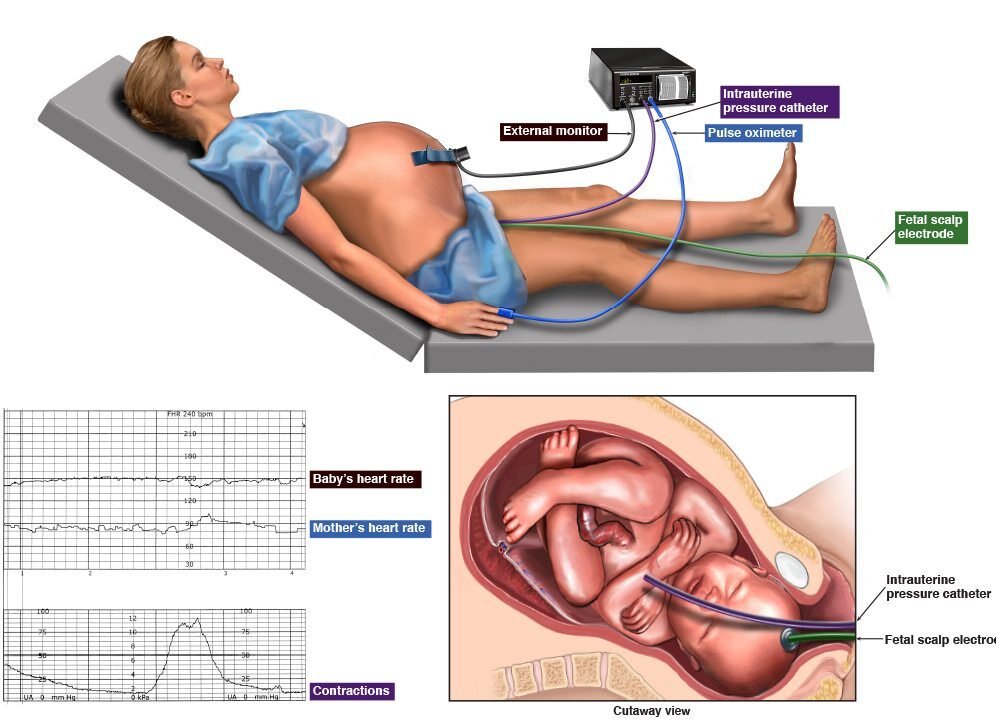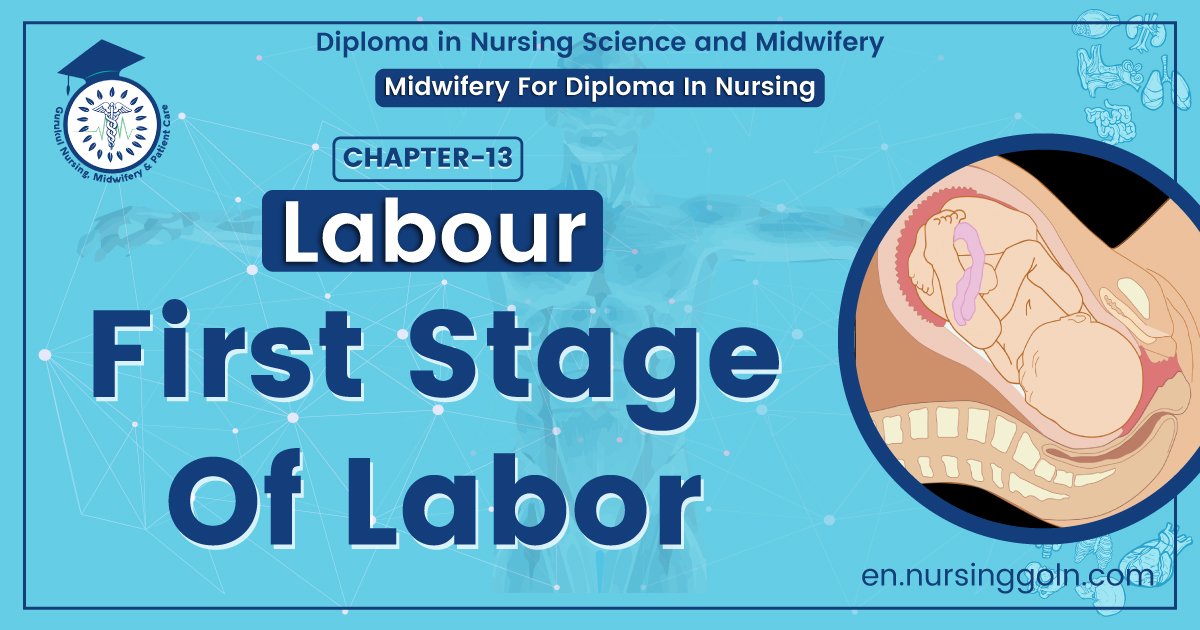First Stage Of Labor – This course is designed to understand the care of pregnant women and newborn: antenatal, intra-natal and postnatal; breast feeding, family planning, newborn care and ethical issues, The aim of the course is to acquire knowledge and develop competencies regarding midwifery, complicated labour and newborn care including family planning.

First Stage Of Labor
First stage of labor
The time of the onset of true labor until the cervix is completely dilated to 10 cm.
The first stage of labor is the longest and involves three phases:
1. Early Labor Phase-The time of the onset of labor until the cervix is dilated to 3 cm.
2. Active Labor Phase-Continues from 3 cm. until the cervix is dilated to 7 cm.
3. Transition Phase-Continues from 7 cm. until the cervix is fully dilated to 10 cm.
Each phase is characterized by different emotions and physical challenges.
Events in First Stage of Labour:
A. Dilatation of the cervix: Factors responsible –
- Uterine contraction and relation
- Bag of membranes
- Fetal axis pressure
B. Taking up of cervix (effacement): It is the process of thinning out of the cervix.
- In primigravida, effacement precedes dilation of the cervix.
- In Multiparae both simultaneously
C. Formation of lower uterine segment: It is the lower part of the uterus which progressive thinned out during labour having property of receptive and poor retractile properly.
Clinical features:
a) Symptoms:
- True labour pain
- Show Sudden gush of liquor amnii (late part)
b) Signs:
- Pulse, BP and temperature raised.
- Per abdominal examination:
✓ Contraction of the uterus
– Intermittent
– At early part interval between to contraction is 15-30 minutes with duration of 30 seconds, later occurs every 3-5 minutes interval duration of 45 seconds.
– Foetal heart sound: 120-140 beat/minutes increase by 10 beat during contraction.
✓ P/V (Per- vaginal) examination:
– Cervix becomes dilated (gradual dilatation from 2-10 cm)
– Gradual effacement of the cervix.
– Status of the membrane-usually rupture at the late part of the first stage.
– Bulging of the membrane during contraction (if the membrane is not ruptured)
Management of 1st Stage of Labour:
Place of delivery: All women, ideally, should be delivered in hospital. The objective in the rural areas should be to hospitalize the high risk pregnancies. The mothers in the low risk group may be delivered at home by rained birth attendants (TВА)
1. Admission in hospital generally the patients are asked to admit when the pain starts.
2. Maintenance of hygiene:
- Shaving of the vulva and wash with soap and water
- Wearing of clean loose garments
- Encouragement and assurance
- Constant supervision
3. Rest: Patent can walk if membrane is intact
4. Diet:
- Liquid diets, food and oral fluids should be withheld as soon as active labour is established.
- If necessary nutrition can be maintained by IV fluid.
5. Care of bowel: Low enema simplex should be given to empty the bowel.

6. Care of bladder: The patient should be encouraged to pass urine by self micturation, if failed catheterization is to be done.
7. Analgesics or pain relief: If untolerable inj. (pethidne 50-100 mg IM (Pethidine is to be given when at least the cervix is 3 cm dilated).
8. Maternal monitoring:
- Vital sign
- Dehydration
- Urinary out put
- Urinary protein and acetone
9. Fetal monitoring:
- Fetal heart rate
- Color of the liquor
- Fetal movement
- Degree of moulding
- Caput formation
10. Assessment of Progression of labour:
a) Abdominal examination: this should include the following points –
✓ Uterine contraction:
- Number of contraction in 10 minutes
- Duration of each contraction in second
✓ Decent of fetal head in fifths is to be determined
✓ Shifted of fetal heart sound downwards medially
b) Vaginal examination: Done at 4 hourly intervals.
- Dilatation of the cervix and effacement
- Position and degree of flexion of the head
- Caput and degree of moulding
- Station of the head in relation to ischial spines.

Nursing considerations:
Care of the Woman During the First Stage:
Nursing interventions:
– Reduce anxiety and offer assistance
– Do not interrupt breathing during contractions
– Promote change of positions
– Encourage voiding and promote bladder care
– Encourage client to suck on hard candy, ice chips
– Apply cream on dry lips of client
– Administer IV solution in case of DHN
– When hyperventilating, keep paper bag nearby and teach on how to use it.
Complication of 1st Stage of Labour:
1. Early rupture of membranes with or without cord prolapsed
2. Hypotonic uterine contraction or incoordinate uterine contraction
3. Cervix dystocia
4. Prolonged 1 stage due to unrecognized brow, minor degree hydrocephalus, mal-position, minor degree CPD, deflexed head etc
5. Foetal distress
6. Intra-partum hemorrhage
7. Cervical dystocia
Read More.
